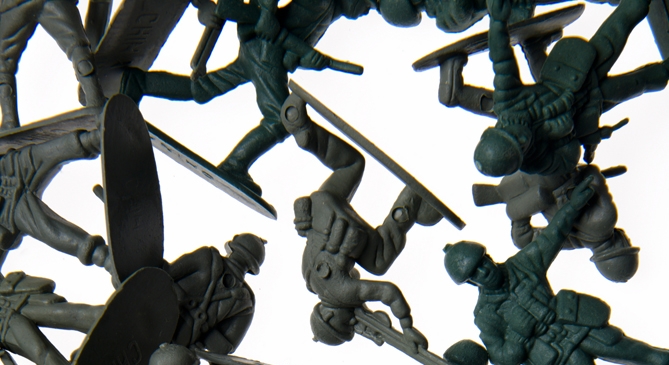
Pooling forces
After many years of talking about boosting their defence capabilities but doing very little, the Europeans have made substantial progress in 1999. European governments have begun to develop the defence dimension of their common foreign and security policy. NATO's spring military campaign against Yugoslavia showed that European nations lacked sufficient offensive airpower, and that they were no better prepared to mount a potentially hostile ground campaign.
In the Kosovo air operation even the United Kingdom, which prides itself on being a serious military power, could contribute only 4 per cent of the aircraft and 4 per cent of the bombs dropped. Tony Blair found that his (and the other Europeans') influence on the war strategy in Washington reflected the relative contributions of the United States and Europe. The Kosovo campaign was essentially fought with American equipment and American doctrine.
European governments now realise that unless they can find ways of turning their two million troops and 3,000 combat aircraft into an effective military force, they will have to accept that the United States will continue to decide the tactics for allied security operations in Europe and elsewhere. So the time is ripe for a serious attempt to rebalance European and American roles within the NATO partnership. Tony Blair is enthusiastic - more so than many in his defence ministry - for real progress on European defence. And many other EU governments are genuinely open to suggestions on how they can make their military forces more useful and cost-effective.
Our long term vision for Europe should foresee the possibility of a distant future when the countries of an enlarged EU, without internal borders, are so interdependent that it will be natural for them to pool and fund all their military capability at the European level. Europe will have vital interests as a global economic power; and it will need a foreign and security policy to protect those interests. To be sure, such a vision may never become reality. However, there are policies to consider in the short- to-medium term which would improve capabilities very quickly - whatever the long term outcome.
In the next few months, the EU could agree on a number of areas where much-needed assets could be pooled at the European level, with much greater effectiveness. This need not endanger national sovereignty: a government would be able to withhold or withdraw its contribution to satisfy a national military requirement. An example of this kind of EU capacity could be a common air transport and air-to-air refuelling force. This could be operated on a similar basis to the longstanding and successful NATO force of AWACS airborne radar aircraft. European navies might build on the example of the Belgian-Dutch joint naval headquarters to operate their frigates in common. Land forces could look to the example of the Nordic countries, which have pooled their logistic support arrangements in Bosnia. In every case more effective capability would be provided at less cost.
In the medium term the focus should move to producing more effective combat forces. Five EU nations are ordering the Eurofighter for delivery from 2002 onwards. Each will set up its own headquarters, training base and support organisations. Over a period of years, each of the five is likely to develop its version of Eurofighter in different ways (as has happened with the Tornados flown by Britain, Germany and Italy), so that the ability of the Eurofighter forces to operate together deteriorates. What is needed is a single EU military headquarters, managing a mixed-nationality Eurofighter force of perhaps 400 aircraft, subject to a common operational doctrine. Any nation that felt the need to retain some independent national capability could rotate its crews and aircraft through the EU force on a regular basis.
The same logic could apply to aircraft carriers, which are currently operated by France, Italy, Spain and the UK. Britain plans to have two new carriers, and the others currently operate one each. But between them, these maritime-minded nations could run a serious military force of four or five carriers. Other EU nations could provide the necessary frigates, submarines and helicopters to support the carriers. As for Europe's armies, there is an evident need for rapidly deployable forces with a wide range of expertise. The EU's recent discussion about a rapid reaction force of at least 40,000 troops could be helpful - but only if structured to cut out wasteful duplication of national logistic and support services.
As the EU moves to BUILD UP its military muscle, it must ensure that there is no free ride for less enthusiastic members. The establishment of a European Defence Budget would spur member-states to take a serious interest in their contribution to European military needs. Nations would be free to contribute either capability or funds. Over time, governments would realise that they got more bang for each euro spent on EU forces, compared with spending on purely national services. Once forces were commanded and operated largely at a European level, common doctrine and operational planning would lead eventually to common equipment requirements. National forces might specialise in particular military roles, but in a system planned by the EU rather than, as today, in a random manner. The inefficiencies of duplication that plague today's multinational forces, with each country having its own training systems, headquarters, supply chains, military planners and defence ministry officials, would be greatly reduced.
Within NATO, Europe would be a more equal partner to the US, and when necessary it would be able to field its own diplomatic and military missions. Once the one-off costs of switching to pan-European defence had been taken into account, the Europeans would not need to spend more on defence than they do today.
